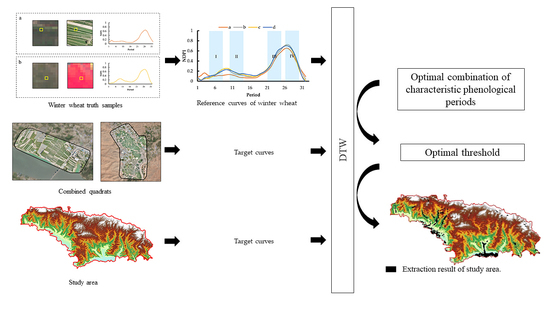Optimization of Characteristic Phenological Periods for Winter Wheat Extraction Using Remote Sensing in Plateau Valley Agricultural Areas in Hualong, China
Abstract
:1. Introduction
2. Materials and Methods
2.1. Study Area
2.2. Data
2.2.1. Satellite Remote Sensing Data
2.2.2. Field Survey Data
2.2.3. Administrative Division Data
2.2.4. Planting Data
2.3. Methods
2.3.1. Vegetation Index
2.3.2. Quality Mosaic Cloud Removal
2.3.3. S-G Filtering
2.3.4. DTW Algorithm
- The target and reference sequences were set as T = T{T(1), T(2), …, T(N)} and R = {R(1), R(2), …, R(M)}, where T(n) and R(m) (n, m) are the n and m eigenvectors of the corresponding sequence, respectively.
- The distance between any two-time series data points is represented by d(T(n), R (m)). The distance function adopts the Euclidean distance, and its formula is stated as follows:
- A search of each path determines the shortest cumulative distance starting from T(N) to R(M) by finding the sum of the minimum distances between each point in T and R. The smaller the shortest cumulative distance is, the more similar T and R are. The threshold of the shortest cumulative distance is set during the extraction of winter wheat in this study. A cumulative distance between the target NDPI and reference NDPI sequences that is less than or equal to this threshold was considered winter wheat; otherwise, it was considered other ground objects (Figure 3).
2.3.5. Receiver Operating Characteristic (ROC) Curve
3. Process and Results
3.1. Data Processing and Results
3.1.1. Construction of the Time Series Vegetation Index
3.1.2. Determination of Samples and Reference Curves
3.2. Optimization of the Combination of Characteristic Phenological Periods and Their Thresholds
3.2.1. Determination of the Optimal Phenological Period Combination Based on Quadrat Individuals
3.2.2. Determination of the Optimal Threshold Based on the Combined Quadrats
3.3. Extraction of Winter Wheat in the Study Area
4. Discussion
4.1. Comparison of NDPI Curve Features of Time Series
4.2. Change in the Optimal Threshold
4.3. Change in Extraction Accuracy
4.4. Change in the Extracted Area from the Superposition of Cultivated Land Data
4.5. Early Identification of Winter Wheat with Cultivated Land Support
5. Conclusions
Author Contributions
Funding
Data Availability Statement
Acknowledgments
Conflicts of Interest
Appendix A
Appendix B
Appendix C
References
- Guo, X.; Wang, N.; Zhang, L.; Guo, Y.; Chu, X.; Feng, H. Extraction of winter wheat information based on time-series NDVl in Guanzhong area. J. Agric. Res. Arid Areas 2020, 38, 275–280. (In Chinese) [Google Scholar]
- Jiang, Y.; Chen, B.; Huang, Y.; Cui, J.; Guo, Y. Crop planting area extraction based on Google Earth Engine and NDVI time series difference Index. J. Geo-Inf. Sci. 2021, 23, 938–947. (In Chinese) [Google Scholar]
- Hu, Q.; Wu, W.; Song, Q.; Yu, Q.; Yang, P.; Tang, H. Recent progresses in research of crop patterns mapping by using remote sensing. J. Sci. Agric. Sin. 2015, 48, 1900–1914. (In Chinese) [Google Scholar]
- Zhang, J.; Zhao, G.; Hong, Y.; Sun, Z.; Duan, Y. Spatial extraction of winter wheat in Hebei in growing season using pixel-wise phenological curve. J. Trans. Chin. Soc. Agric. Eng. 2020, 36, 193–200. (In Chinese) [Google Scholar]
- Conese, C.; Maselli, F. Use of multitemporal information to improve classification performance of TM scenes in complex terrain. J. ISPRS J. Photogramm. Remote Sens. 1991, 46, 187–197. [Google Scholar] [CrossRef]
- Li, R.; Li, G.; Lu, X.; Zhang, X.; Yu, H. An improved method of winter wheat remote sensing recognition based on time series. J. Sci. Surv. Mapp. 2022, 47, 73–79+110. (In Chinese) [Google Scholar]
- Pan, Y.; Li, L.; Zhang, J.; Liang, S.; Hou, D. Crop area estimation based on MODIS-EVI time series according to distinct characteristics of key phenology phases: A case study of winter wheat area estimation in small-scale area. J. Remote Sens. 2011, 15, 578–594. (In Chinese) [Google Scholar]
- Chen, J.; Tian, Q. Vegetation classification based on high-resolution satellite image. J. Remote Sens. 2007, 11, 221–227. [Google Scholar]
- Zhao, Y.; Wang, X.; Hou, X. Spatio-temporal characteristics of key phenology of winter wheat in Shandong Province from 2003 to 2019. Acta Ecol. Sin. 2021, 41, 7785–7795. [Google Scholar]
- Luo, Y.; Zhang, C.; Zhang, L. Simulation of spatial and temporal variability of winter wheat phenology and analysis of its climate drivers based on an improved pDSSAT model. Sci. Sin. (Terrae) 2022, 52, 126–143. [Google Scholar]
- Liu, Y.; Chen, Q.; Ge, Q. Spatiotemporal differentiation of changes in wheat phenology in China under climate change from 1981 to 2010. Sci. Sin. (Terrae) 2018, 48, 888–898. (In Chinese) [Google Scholar] [CrossRef]
- Wang, H.; Gong, Y.; Liu, W.; Li, Z.; Zhang, S. Study on spatial-temporal multiscale adaptive method of gesture recognition. Comput. Sci. 2017, 44, 287–291. [Google Scholar]
- Bankó, Z.; Abonyi, J. Correlation based dynamic time warping of multivariate time series. Expert Syst. Appl. 2012, 17, 12814–12823. [Google Scholar] [CrossRef]
- Petitjean, F.; Inglada, J.; Gançarski, P. Satellite image time series analysis under time warping. IEEE Trans. Geosci. Remote Sens. 2012, 50, 3081–3095. [Google Scholar] [CrossRef]
- Guan, X.; Huang, C.; Liu, G.; Xu, Z.; Liu, Q. Extraction of paddy rice area using a DTW distance based similarity measure. Resour. Sci. 2014, 36, 267–272. [Google Scholar]
- Sakoe, H.; Chiba, S. Dynamic programming algorithm optimization for spoken word recognition. IEEE Trans. Acoust. Speech Signal Process. 1978, 26, 43–49. [Google Scholar] [CrossRef] [Green Version]
- Hamooni, H.; Mueen, A.; Neel, A. Phoneme sequence recognition via DTW-based classification. Knowl. Inf. Syst. 2016, 48, 253–275. [Google Scholar] [CrossRef]
- Maus, V.; Câmara, G.; Appel, M.; Pebesma, E. dtwsat: Time-weighted dynamic time warping for satellite image time series analysis in R. J. Stat. Softw. 2019, 88, 1–31. [Google Scholar] [CrossRef] [Green Version]
- Duan, J.; Xu, Y.; Sun, X.-Y. Spatial patterns and their changes of grain production, grain consumption and grain security in the Tibetan Plateau. J. Nat. Res. 2019, 34, 673–688. (In Chinese) [Google Scholar] [CrossRef]
- Liu, M.; Wang, B.; Zhong, J. Population-Economic-Grain Regional Difference and Spatial Pattern of Qinghai Province in the Past 30 Years. Northwest Popul. J. 2021, 42, 113–124. (In Chinese) [Google Scholar]
- Chen, Y.; Zhou, Q.; Chen, Q.; Mao, X.; Liu, F. The response of grain crops in Hehuang Valley to the climate change nearly 20 years. Agric. Res. Arid Areas 2018, 36, 223–229, 241. [Google Scholar]
- Chen, R.; Zhou, Q.; Liu, F.; Zhang, Y.; Chen, Q.; Chen, Y. Contribution of climate change to food yield in Yellow River-Huangshui River Valley. Hubei Agric. Sci. 2018, 57, 114–119. (In Chinese) [Google Scholar]
- Huang, F.; Xia, X.; Huang, Y.; Lv, S.; Chen, Q.; Pan, Y.; Zhu, X. Comparison of winter wheat extraction methods based on different time series of vegetation indices in the Northeastern margin of the Qinghai–Tibet Plateau: A case study of Minhe, China. Remote Sens. 2022, 14, 343. [Google Scholar] [CrossRef]
- Gu, X.; Song, G.; Han, J.; Xu, C.; Pan, Y. Monitoring of growth changes of winter wheat based on change vector analysis. Trans. CSAE 2008, 24, 159–165+1. (In Chinese) [Google Scholar]
- Singh, R.; Semwal, D.P.; Rai, A.; Chhikara, R.S. Small area estimation of crop yield using remote sensing satellite data. Int. J. Remote Sens. 2002, 23, 49–56. [Google Scholar] [CrossRef]
- Hualong County People’s Government Official Website. Available online: http://www.hualongxian.gov.cn/html/1143/294809.html (accessed on 2 May 2021). (In Chinese)
- Jin, X.; Ma, J. Discussion on the conditions and control technology of yellow dwarf disease of wheat in Hualong County. Qinghai Agro-Technol. Ext. 1999, 4, 60. (In Chinese) [Google Scholar]
- Hualong County becomes one of the largest winter wheat production bases in the province. Cereals Oils Process. 2009, 8, 19. (In Chinese)
- The Harvested Crop Area in Hualong Reaches 166,000 mu. Available online: http://www.moa.gov.cn/xw/qg/201909/t20190927_6329164.htm (accessed on 15 December 2022). (In Chinese)
- Hualong County Had a Good Harvest of Winter Wheat. Available online: http://www.qinghai.gov.cn/zwgk/system/2020/07/14/010362574.shtml (accessed on 15 December 2022). (In Chinese)
- Hualong: Thousands of Hectares of Winter Wheat Green Yellow River Valley. Available online: https://epaper.tibet3.com/qhrb/html/202210/24/content_114965.html (accessed on 15 December 2022). (In Chinese).
- Winter Wheat is Growing Well in Hualong County. Available online: http://www.dbcsq.com/dbcsq/202210/190838.html (accessed on 15 December 2022). (In Chinese).
- Tian, Y.; Jia, M.; Wang, Z.; Mao, D.; Du, B.; Wang, C. Monitoring invasion process of Spartina alterniflora by seasonal Sentinel-2 imagery and an object-based random forest classification. Remote Sens. 2020, 12, 1383. [Google Scholar] [CrossRef]
- Song, H.; Lei, H.; Shang, M. Crop classification based on Sentinel 2A/B time series data in Heilonggang river basin. Jiangsu J. Agric. Sci. 2021, 37, 83–92. [Google Scholar]
- The National Catalogue Service for Geographic Information. Available online: https://www.webmap.cn/main.do?method=index (accessed on 2 May 2021). (In Chinese).
- Fan, D.; Zhao, X.; Zhu, W.; Zheng, Z. Review of influencing factors of accuracy of plant phenology monitoring based on remote sensing data. Prog. Geogr. 2016, 35, 304–319. (In Chinese) [Google Scholar]
- Luo, Y.; Xu, J.; Yue, W. Research on vegetation indices based on the remote sensing images. Ecol. Sci. 2005, 24, 75–79. (In Chinese) [Google Scholar]
- Dong, Q.; Chen, X.; Chen, J.; Zhang, C.; Liu, L.; Cao, X.; Zang, Y.; Zhu, X.; Cui, X. Mapping winter wheat in North China using Sentinel 2A/B data: A method based on phenology-time weighted dynamic time warping. Remote Sens. 2020, 12, 1274. [Google Scholar] [CrossRef] [Green Version]
- Shi, X.; Ming, Y.; Liu, C.; Qu, Y.; Sui, S. Analysis on the application of time series image in extraction of winter wheat planting area. Radio Eng. 2021, 51, 1567–1576. (In Chinese) [Google Scholar]
- Li, F.; Ren, J.; Wu, S.; Zhang, N.; Zhao, H. Effects of NDVI time series similarity on the mapping accuracy controlled by the total planting area of winter wheat. Trans. CSAE 2021, 37, 127–139. (In Chinese) [Google Scholar]
- Liang, S.; Shi, P.; Xing, Q. A Comparison Between the Algorithms for Removing Cloud Pixel from MODIS NDVI Time Series Data. Remote Sens. Nat. Resour. 2011, 1, 33–36. (In Chinese) [Google Scholar]
- Carreiras, J.M.B.; Pereira, J.M.C.; Shimabukuro, Y.E.; Stroppiana, D. Evaluation of compositing algorithms over the Brazilian Amazon using SPOT-4 VEGETATION data. Int. J. Remote Sens. 2003, 24, 3427–3440. [Google Scholar] [CrossRef]
- Viovy, N.; Arino, O.; Belward, A.S. The Best Index Slope Extraction (BISE): A method for reducing noise in NDVI time-series. Int. J. Remote Sens. 1992, 13, 1585–1590. [Google Scholar] [CrossRef]
- Lovell, J.L.; Graetz, R.D. Filtering pathfinder AVHRR land NDVI data for Australia. Int. J. Remote Sens. 2001, 22, 2649–2654. [Google Scholar] [CrossRef]
- Savitzky, A.; Golay, M.J.E. Smoothing and differentiation of data by simplified least squares procedures. Anal. Chem. 1964, 36, 1627–1639. [Google Scholar] [CrossRef]
- Li, H.-Y.; Jia, Y.-W.; Ma, M.-G. Reconstruction of temporal NDVI dataset: Evaluation and case study. Remote Sens. Technol. Appl. 2009, 24, 596–602. (In Chinese) [Google Scholar]
- Chen, J.; Jönsson, P.; Tamura, M.; Gu, Z.; Matsushita, B.; Eklundh, L. A simple method for reconstructing a high-quality NDVI time-series data set based on the Savitzky–Golay filter. Remote Sens. Environ. 2004, 91, 332–344. [Google Scholar] [CrossRef]
- Zhao, H.; Zhou, Y.; Pei, T.; Chen, Y.; Xie, B. Spatiotemporal analyses of vegetation coverage variation and its responses to slope in Middle East of Gansu Province. Remote Sens. Inf. 2019, 34, 133–139. (In Chinese) [Google Scholar]
- Dong, J.; Fu, Y.; Wang, J.; Tian, H.; Fu, S.; Niu, Z.; Han, W.; Zheng, Y.; Huang, J.; Yuan, W. Early-season mapping of winter wheat in China based on Landsat and Sentinel images. Earth Syst. Sci. Data 2020, 12, 3081–3095. [Google Scholar] [CrossRef]
- Zhang, Y. Query tree feature extraction based on data mining for detecting SQL injection attack. Appl. Electron. Tech. 2016, 42, 90–94. [Google Scholar]
- Zhu, W.; Zeng, N.; Wang, N. Sensitivity, specificity, accuracy, associated confidence interval and ROC analysis with practical SAS implementations. In Proceedings of the NESUG 2010: Health Care and Life Sciences, Baltimore, MA, USA, 14–17 November 2010. [Google Scholar]



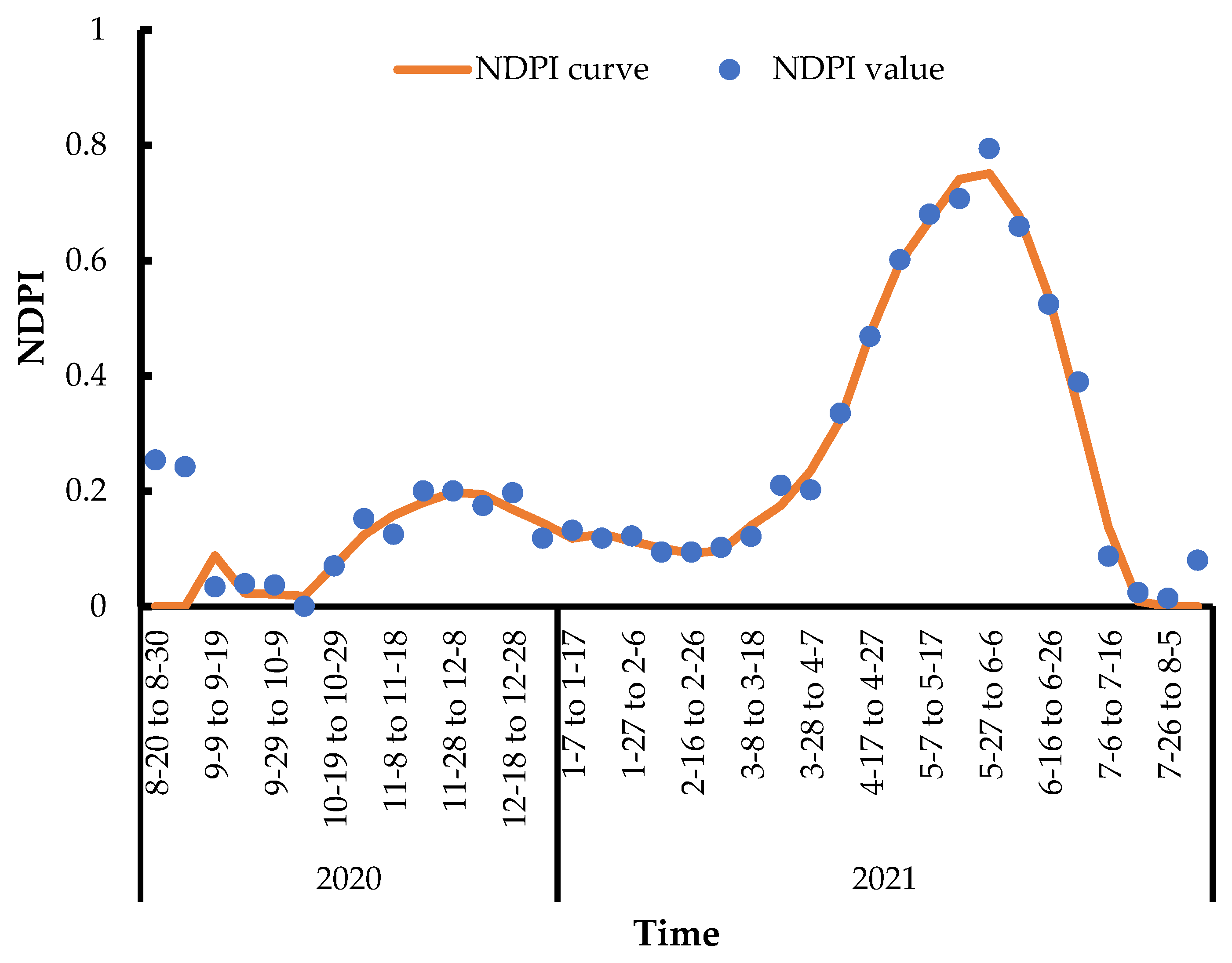
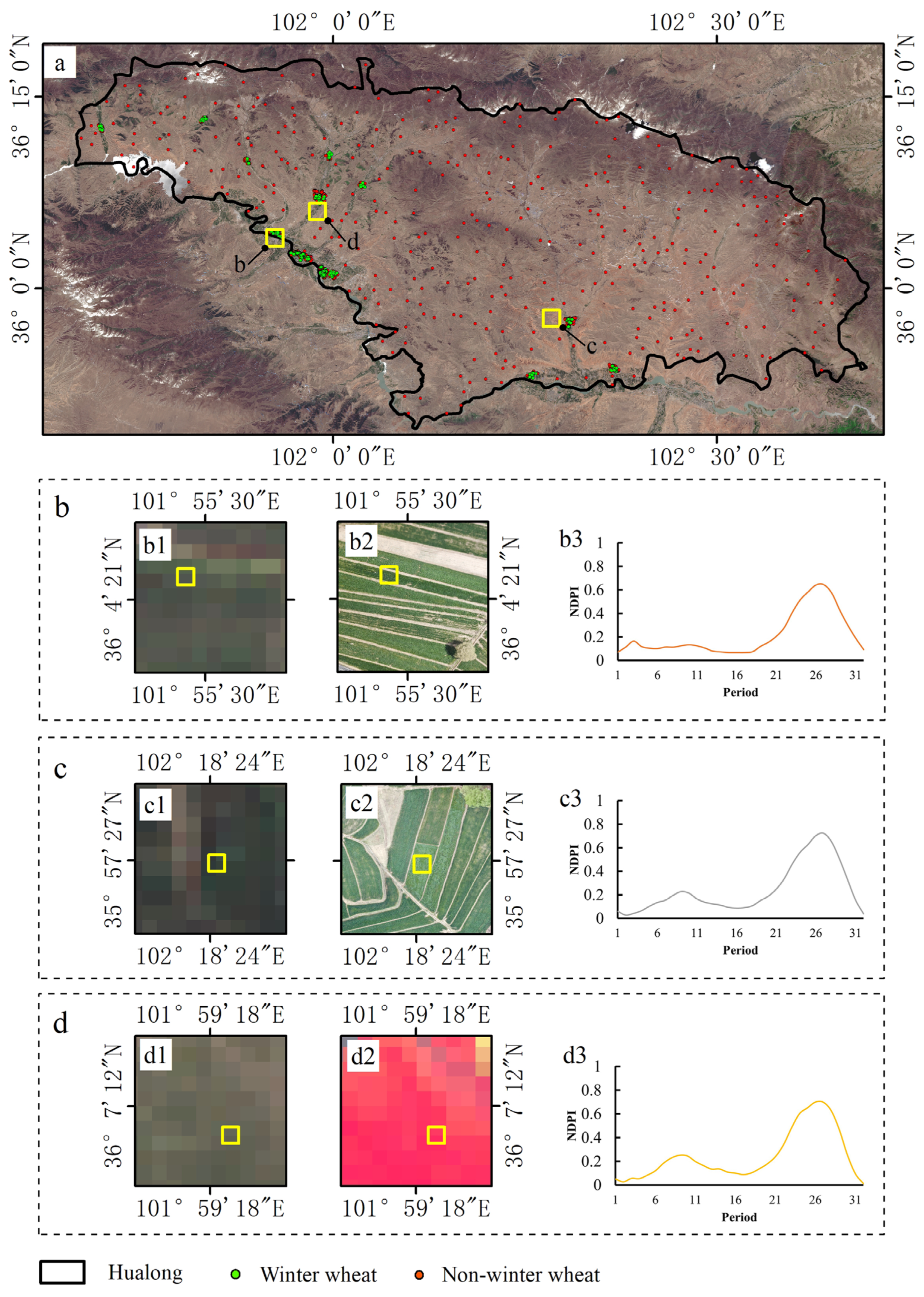

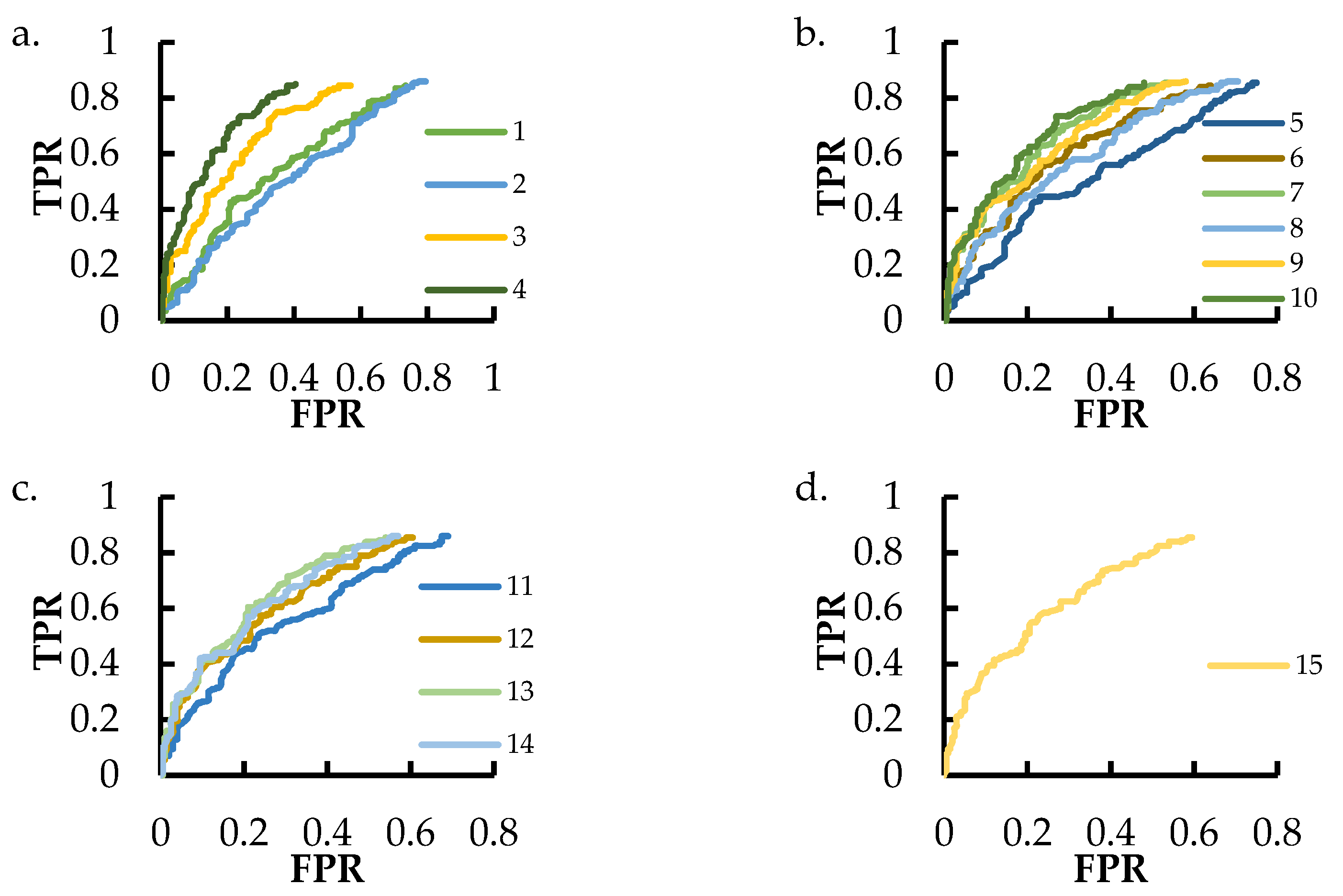

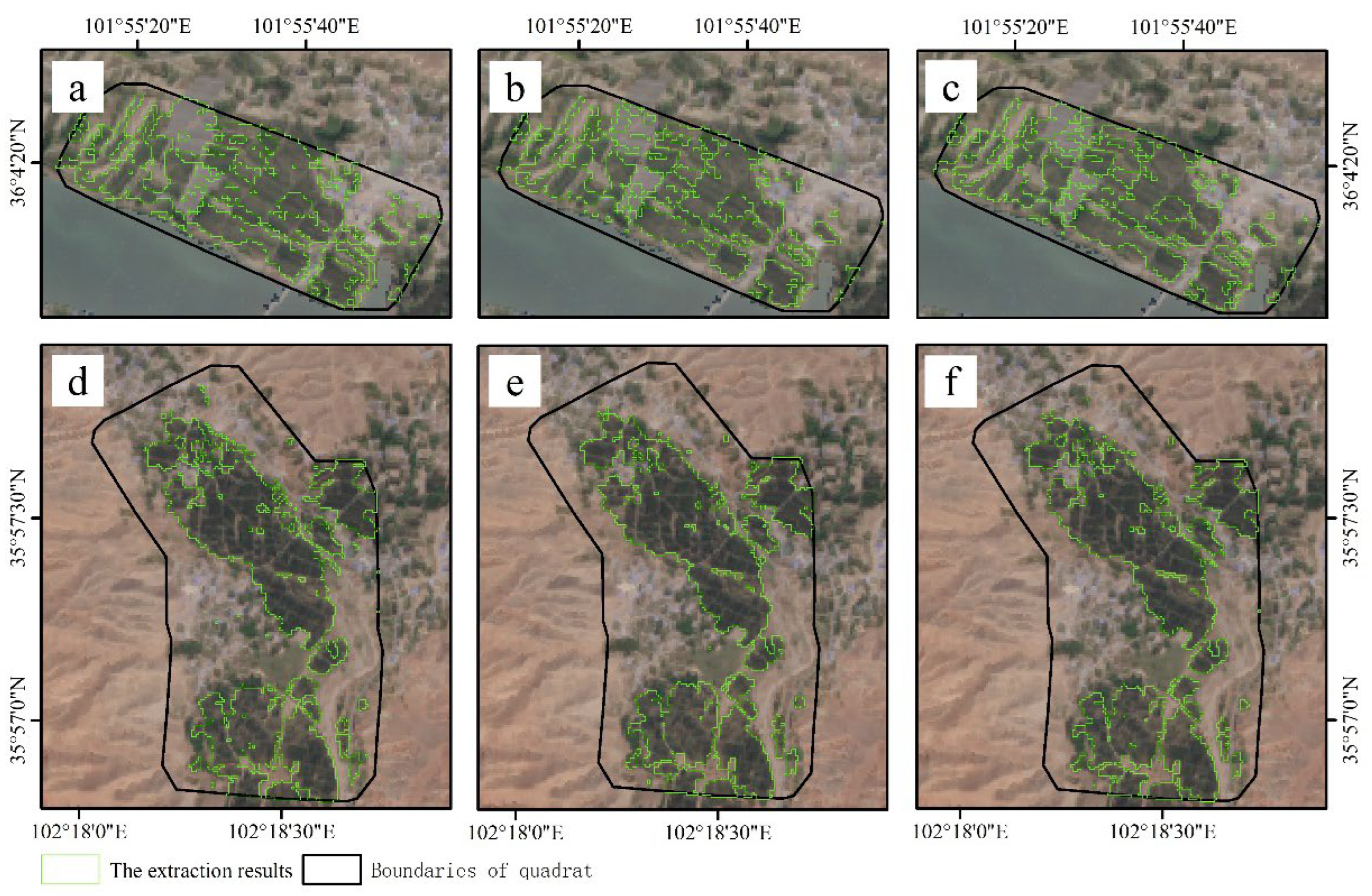
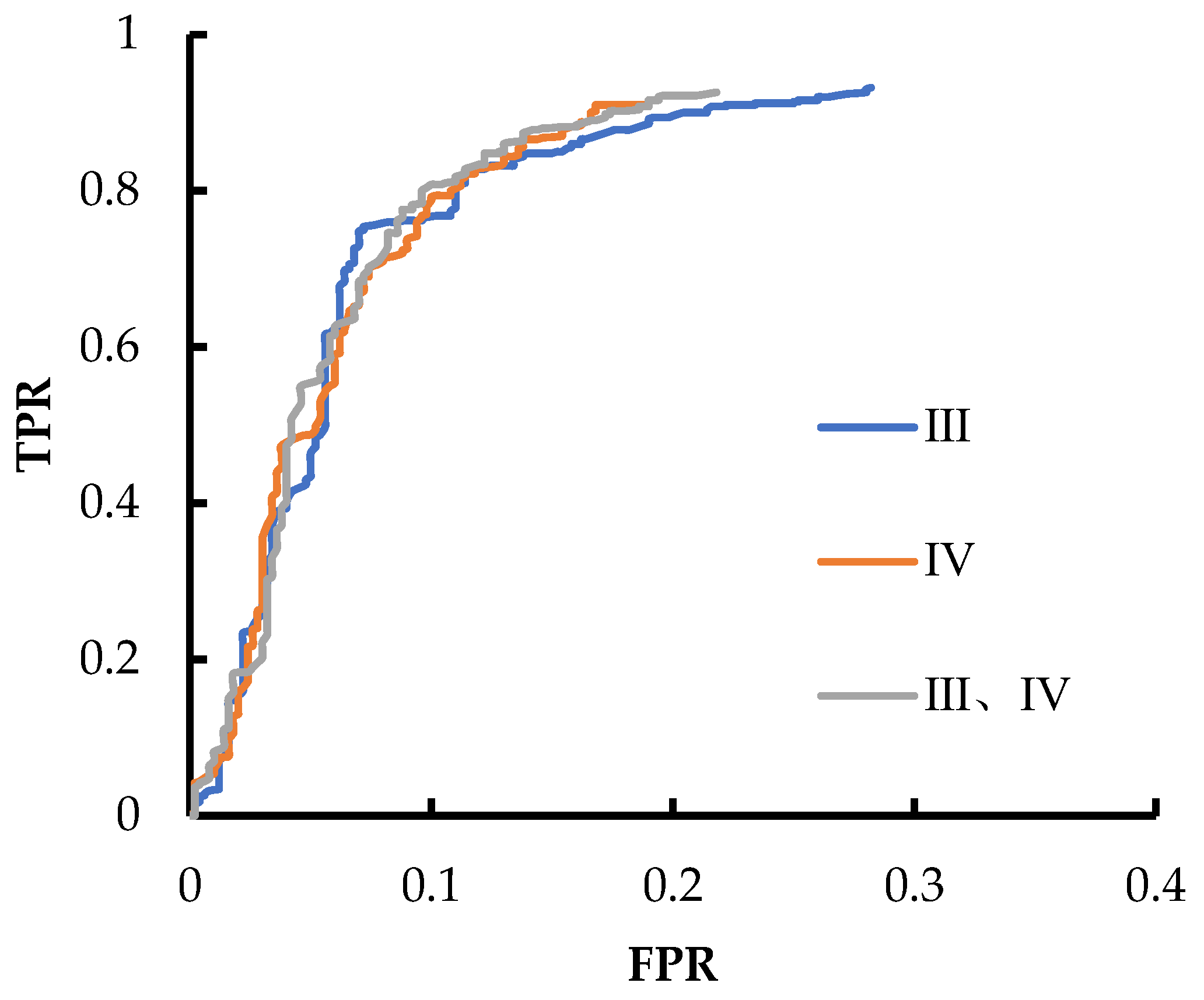

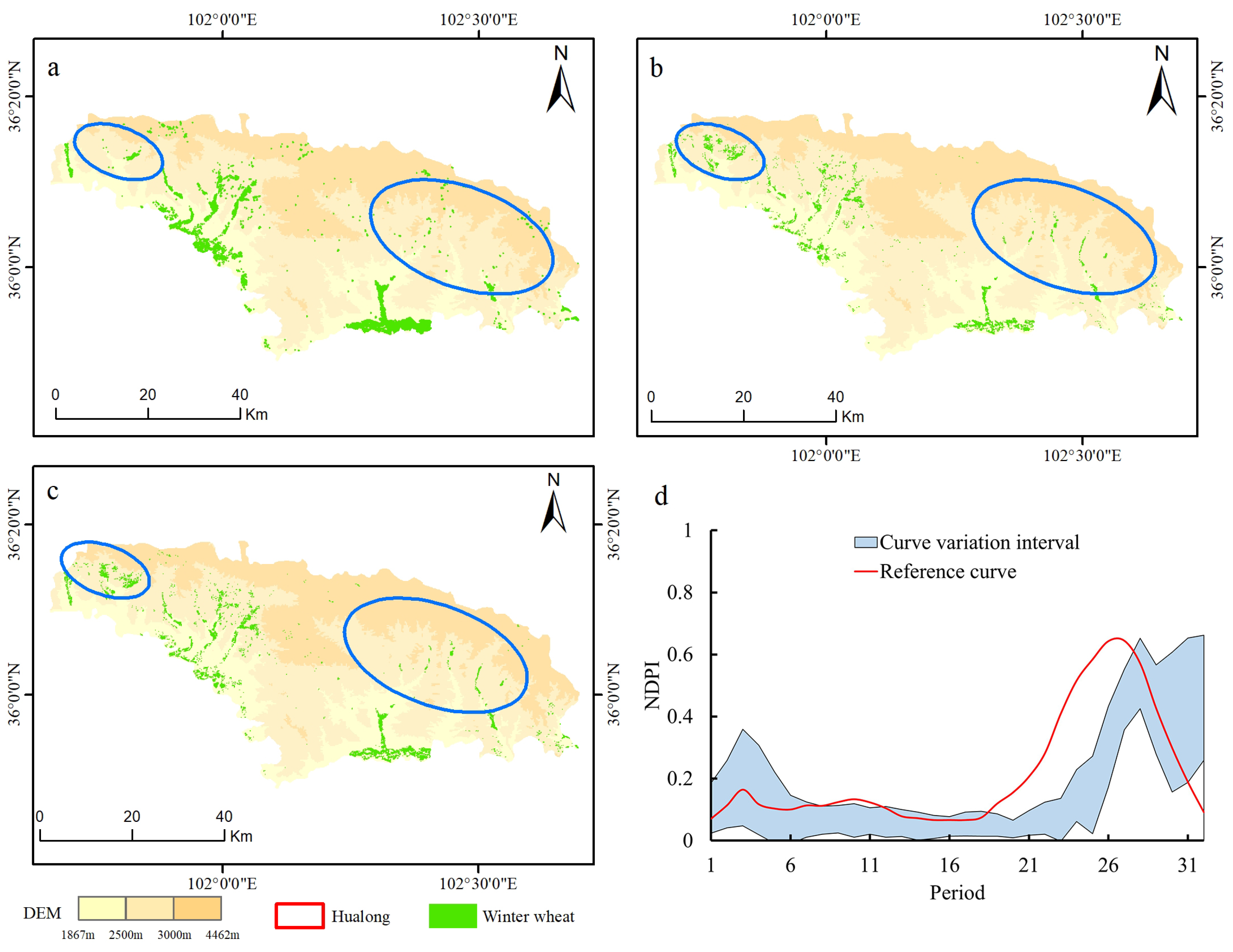

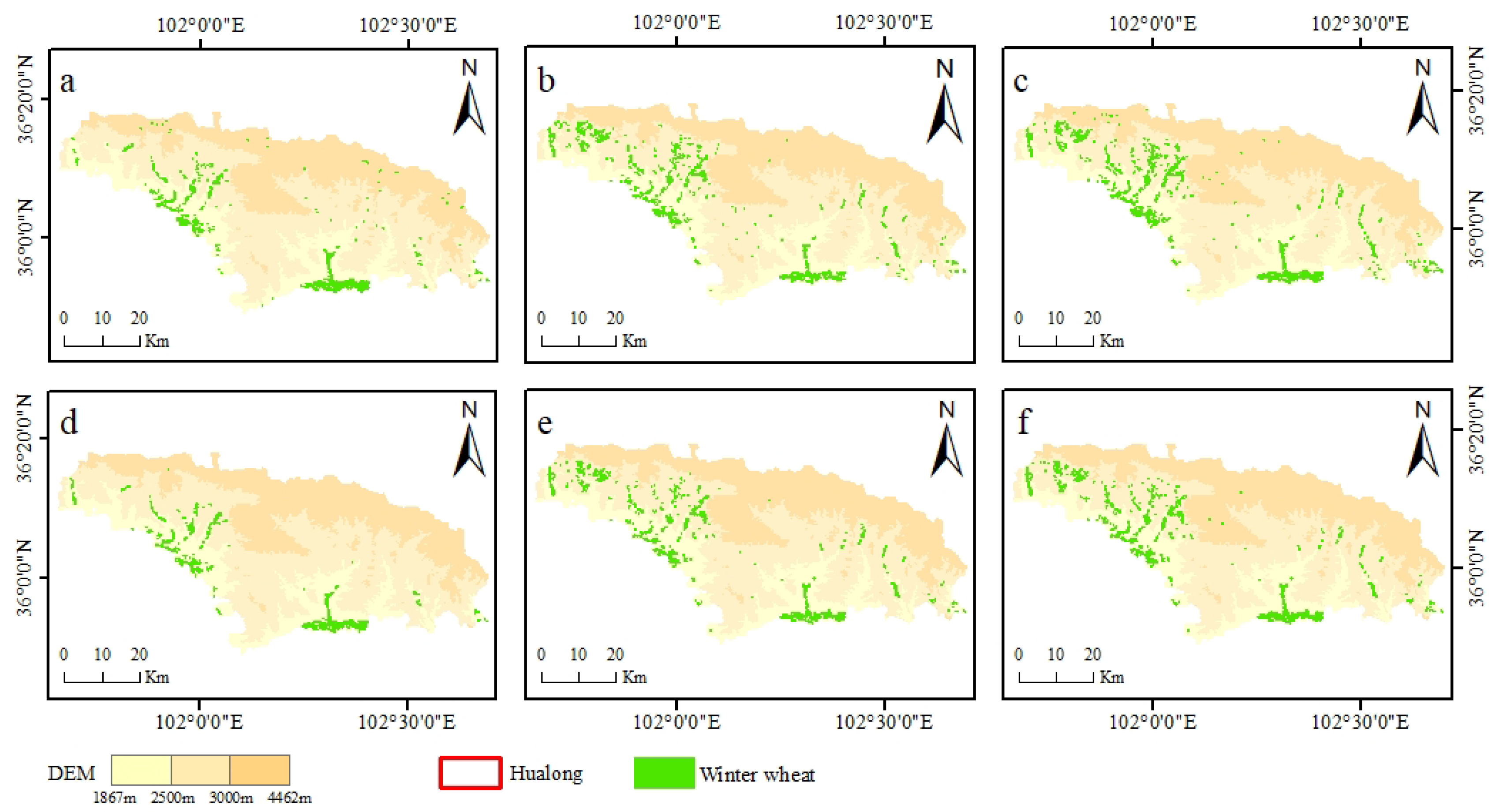
| Period | 3 | 7 | 12 | 17 | 22 | 27 | 34 |
|---|---|---|---|---|---|---|---|
| Start date | 2020/9/9 | 2020/10/19 | 2020/12/8 | 2021/1/27 | 2021/3/18 | 2021/5/7 | 2021/6/26 |
| End date | 2020/9/19 | 2020/10/29 | 2020/12/18 | 2021/2/6 | 2021/3/8 | 2021/5/17 | 2021/7/26 |
| Study Scale | Winter Wheat Truth Points for Experiment | Winter Wheat Truth Points for Verification | Non-Winter Wheat Truth Points |
|---|---|---|---|
| Quadrat 1 | 50 | 200 | 200 |
| Quadrat 2 | 100 | 400 | 400 |
| Overall quadrat | 150 | 600 | 600 |
| Overall study area | 200 | 1000 | 1000 |
| Stage | I | II | III | IV |
|---|---|---|---|---|
| Periods | 4 to 8 | 10 to 14 | 21 to 25 | 26 to 30 |
| Start and end time | 2020/9/19 to 2020/10/29 | 2020/11/18 to 2021/1/7 | 2021/3/8 to 2021/4/27 | 2021/4/27 to 2021/6/16 |
| Sequence Number | Phenological Stage Combinations | Quadrat 1 | Quadrat 2 | ||
|---|---|---|---|---|---|
| Optimal Threshold | ACC | Optimal Threshold | ACC | ||
| 1 | I | 0.085 | 0.608 | 0.084 | 0.7275 |
| 2 | II | 0.103 | 0.57 | 0.075 | 0.789 |
| 3 | III | 0.182 | 0.7 | 0.132 | 0.905 |
| 4 | IV | 0.181 | 0.748 | 0.168 | 0.916 |
| 5 | I, II | 0.088 | 0.608 | 0.071 | 0.755 |
| 6 | I, III | 0.125 | 0.663 | 0.108 | 0.871 |
| 7 | I, IV | 0.169 | 0.708 | 0.126 | 0.898 |
| 8 | II, III | 0.13 | 0.635 | 0.131 | 0.888 |
| 9 | II, IV | 0.163 | 0.685 | 0.135 | 0.905 |
| 10 | III, IV | 0.181 | 0.732 | 0.14 | 0.908 |
| 11 | I, II, III | 0.114 | 0.63 | 0.102 | 0.866 |
| 12 | I, II, IV | 0.132 | 0.668 | 0.121 | 0.894 |
| 13 | II, III, IV | 0.173 | 0.705 | 0.134 | 0.9 |
| 14 | I, III, IV | 0.177 | 0.685 | 0.136 | 0.905 |
| 15 | I, II, III, IV | 0.175 | 0.678 | 0.119 | 0.898 |
| Plan | T | TPR | FPR | ACC |
|---|---|---|---|---|
| Plan A | 0.142 | 0.74 | 0.167 | 0.787 |
| Plan B | 0.195 | 0.788 | 0.178 | 0.805 |
| Plan C | 0.183 | 0.783 | 0.195 | 0.794 |
| Plan | T | TPR | FPR | ACC | Area |
|---|---|---|---|---|---|
| Plan A | 0.142 | 0.828 | 0.116 | 0.856 | 24,130 mu (1689.1 ha) |
| Plan B | 0.195 | 0.854 | 0.136 | 0.859 | 50,110 mu (3507.7 ha) |
| Plan C | 0.183 | 0.874 | 0.138 | 0.868 | 33,950 mu (2376.5 ha) |
| Plan | Area without Cultivated Land Support | Area with Cultivated Land Support |
|---|---|---|
| Plan A | 2413 mu (1689.7 ha) | 2092 mu (1464.4 ha) |
| Plan B | 5011 mu (3507.7 ha) | 4352 mu (3046.4 ha) |
| Plan C | 3395 mu (2376.5 ha) | 3001 mu (2100.7 ha) |
| Quadrat | Quadrat 1 | Quadrat 1 | Quadrat 2 | Quadrat 2 | Overall Quadrat | Overall Quadrat |
|---|---|---|---|---|---|---|
| Phenological period | I | II | I | II | I | II |
| Optimal threshold | 0.085 | 0.103 | 0.084 | 0.075 | 0.113 | 0.102 |
| ACC without cultivated land support | 0.608 | 0.570 | 0.728 | 0.789 | 0.598 | 0.60 |
| ACC with cultivated land support | 0.640 | 0.625 | 0.830 | 0.819 | 0.723 | 0.695 |
Disclaimer/Publisher’s Note: The statements, opinions and data contained in all publications are solely those of the individual author(s) and contributor(s) and not of MDPI and/or the editor(s). MDPI and/or the editor(s) disclaim responsibility for any injury to people or property resulting from any ideas, methods, instructions or products referred to in the content. |
© 2022 by the authors. Licensee MDPI, Basel, Switzerland. This article is an open access article distributed under the terms and conditions of the Creative Commons Attribution (CC BY) license (https://creativecommons.org/licenses/by/4.0/).
Share and Cite
Lv, S.; Xia, X.; Pan, Y. Optimization of Characteristic Phenological Periods for Winter Wheat Extraction Using Remote Sensing in Plateau Valley Agricultural Areas in Hualong, China. Remote Sens. 2023, 15, 28. https://doi.org/10.3390/rs15010028
Lv S, Xia X, Pan Y. Optimization of Characteristic Phenological Periods for Winter Wheat Extraction Using Remote Sensing in Plateau Valley Agricultural Areas in Hualong, China. Remote Sensing. 2023; 15(1):28. https://doi.org/10.3390/rs15010028
Chicago/Turabian StyleLv, Shenghui, Xingsheng Xia, and Yaozhong Pan. 2023. "Optimization of Characteristic Phenological Periods for Winter Wheat Extraction Using Remote Sensing in Plateau Valley Agricultural Areas in Hualong, China" Remote Sensing 15, no. 1: 28. https://doi.org/10.3390/rs15010028




